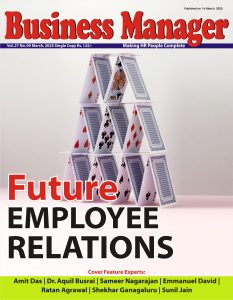Latest PwC Pulse Survey shows that human resource leaders are looking to reduce overall headcount and focus on finding talent with specific skills. In spite of increased job creation and declining unemployment, many companies are looking to strategically manage headcount to help navigate shifting economic headwinds. Maintaining strategic workforce investments while pulling back on overall spending shows a clear switch from a reactive to a proactive policy.
The most significant change reported by CHROs of the past six months has been a shift in the nature of remote, hybrid and in-person workers: Companies are pulling back on hiring. As more and more companies accept the new realities of flexible working environments, many are leaning into the benefits of streamlined, partially or wholly remote positions staffed by skilled workers.
Also read: Differences Over Labour Codes, Trade Unions Demand Tripartite Conference
Companies are focused on making sure they’re not just hiring people, but hiring the right people.83%of CHROs say their companies are considering or have already reduced overall headcount.
Back in January, employers were scrambling to fill open positions. Many managers had never led through a period of economic downturn and have since worked to lead and build trust among their teams. Offering personalized benefits packages, increased flexibility, higher compensation and more promotion opportunities helped companies attract new candidates from competitors, colleges and apprenticeship programs while providing career advancement and training opportunities within their ranks.
Today, the labor market is showing signs of returning to a more familiar state. We’re starting to see companies take more proactive steps to establish an appropriate mix of employees. Skilled workers, still in high demand, may be more empowered, more fulfilled and more likely to grow. It will be important for leaders to manage workplace inequities between skilled and unskilled workers.
And when it comes to scaling back, CHROs are on the front line. Sixty percent indicate their companies are dropping or reducing signing bonuses (versus 46% of executives overall) and 61% are rescinding offers entirely (compared to 44% overall).
Looking forward, CHROs see the recent shift in the labor market continuing. Almost half (48%) of CHROs say it’s likely that voluntary turnover will return to the pre-pandemic rate in the next 12 months. Even more (53%) say it’s likely that the labor market will shift to favor employers over employees in the next 12 months.
What you can do: Think strategically. What job functions are absolutely necessary for accelerating growth at your company? Which can be streamlined, automated or reduced? Consider if you can scale back in some areas while still growing others. For example, if you want to reduce headcount through automation, the first step may be, ironically, hiring automation experts.
From compensation packages to vaccine mandates, human resource executives are starting to make changes.38%of CHROs report that they have increased employee compensation recently. Temporary and one-off solutions run their course
Many companies offered expanded benefits and one-time compensation adjustments over the past two years in response to an employee’s market, combined with the pandemic, inflation, supply chain and a host of other external woes.
While compensation investments still continue to be a lever companies can pull, many are pulling back when it comes to dramatic compensation increases like those seen during the Great Resignation. Today, 38% of CHROs report they’ve recently increased employee compensation and another 35% say they plan to but haven’t yet started. But CHROs are also significantly more likely than other executives to consider cost-saving measures like hiring freezes, rescinding job offers and lowering or all-out dropping signing bonuses.
Easing public health concerns have likewise contributed to some reversals in earlier in-office policies. Whereas 62% of respondents had previously implemented vaccine mandates with another 19% weighing the idea, today a little over one-third of CHROs (34%) have already dropped mandates and another third (33%) are prepared to do so. (Just 7% say they don’t plan on rescinding it at all.) Concern for on-site employee safety in regard to COVID-19 has likewise dropped seven points to just 24%.
What you can do: Be flexible. Determine where in your workforce further investments would be of most benefit and prioritize.
Investments in providing employees with choice and flexibility in where and when they work — and the well-being resources to maintain that flexibility — remain a leading priority.82%of CHROs are working on expanding permanent remote work. Give employees flexibility in choosing when and where they work
Customizing the employee experience — including options for remote work and expanded mental health benefits — is now standard for most businesses, and CHROs know that better than anyone. Giving employees flexibility in choosing when and where they work is one way to demonstrate that you are investing in your workforce.
When asked how they’re addressing aspects of their workforce policy, 82% of CHROs say they’ve already implemented or have a plan to expand permanent remote work options for roles that allow it — 12 percentage points higher than the average business leader. Breaking it down further, 39% of CHROs say they’ve already made remote work permanent where possible, up from the 29% who said the same back in January. Expanding remote work options means many CHROs are able to decrease their real estate footprint and save money, and 65% of those surveyed tell us they’ll maintain or decrease their real estate investments over the next twelve months.
The push for more mental health benefits has likewise increased with 76% of CHROs responding that they already have or plan to expand what they offer around mental health. This is higher than the 64% of CHROs who said the same in January. When specifically asked how they will prioritize talent initiatives in the next 6 to 12 months, 28% say they will make well-being initiatives a top-3 priority. Further, 22% say that reimagining benefits and/or rewards programs is a top-3 priority.
What you can do: Be open. Weigh which positions truly need to be in-person or hybrid and which could be performed entirely remote. It may be possible to tap resources in cheaper labor markets when building out teams that don’t require in-person collaboration.
Employers may want workers to go back to the office, but many can’t — or may not want to.31%of CHROs say transportation issues are a top concern when returning to in-person work.
CHROs have a number of concerns about plans to wind down work-from-home policies, but the main issues appear to be transportation and backlash from employees. As inflation and gas prices remain elevated, 31% of CHROs are concerned that inadequate local transportation infrastructure can’t handle returning commuters or that their employees simply can’t afford the cost of driving into an office.
Remote work weighed heavily on many public transportation systems. Ridership plummeted, impacting both service and safety. Adding to local travel woes, air travel has remained fraught with additional headaches, ranging from ever-changing health regulations to an increase in flight delays and cancellations. Some companies calling for employees to return to the office are seeing resistance from workers who got used to working remotely, with some even choosing to quit rather than give up remote work.
Nearly one in four executives are concerned about remote workers being treated differently than in-person employees. Other concerns — such as maintaining a fully stocked and staffed office, the availability of dependent care and on-site safety of employees — are also on CHROs’ minds.
About the survey
PwC fielded 1st Aug. to 5th Aug.22 surveyed 722 executives and board members from Fortune 1000 and private companies about the current business environment, the risks executives are facing and the impact those risks have on company strategy and growth plans. Of the respondent pool, 98 are CHROs.
Stay connected with us on social media platform for instant update click here to join our LinkedIn, Twitter & Facebook
































Add comment